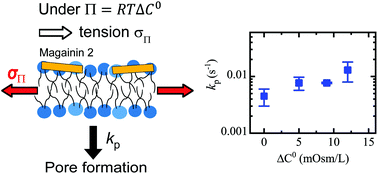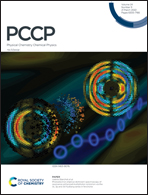Effect of osmotic pressure on pore formation in lipid bilayers by the antimicrobial peptide magainin 2
Abstract
Osmotic pressure (Π) induces membrane tension in cells and lipid vesicles, which may affect the activity of antimicrobial peptides (AMPs) by an unknown mechanism. We recently quantitated the membrane tension of giant unilamellar vesicles (GUVs) due to Π under physiological conditions. Here, we applied this method to examine the effect of Π on the interaction of the AMP magainin 2 (Mag) with single GUVs. Under low Π values, Mag induced the formation of nanometer-scale pores, through which water-soluble fluorescent probe AF488 permeates across the membrane. The rate constant for Mag-induced pore formation (kp) increased with increasing Π. It has been proposed that the membrane tension in the GUV inner leaflet (σin) caused by Mag binding to the outer leaflet plays a vital role in Mag-induced pore formation. During the interactions between Mag and GUVs under Π, the σin increases due to Π, thereby increasing kp. The relationship between the kp and the total σin due to Π and Mag agreed with that without Π. In contrast, Mag induced rupture of a subset of GUVs under higher Π. Using fluorescence microscopy with a high-speed camera, the GUV rupture process was revealed. First, a small micrometer-scale pore was observed in individual GUVs. Then, the pore radius increased within ∼100 ms without changing the GUV diameter and concomitantly the thickness of the membrane at the pore rim increased, and finally the GUV transformed into a membrane aggregate. Based on these results, we discussed the effect of Π on Mag-induced damage of GUV membranes.



 Please wait while we load your content...
Please wait while we load your content...